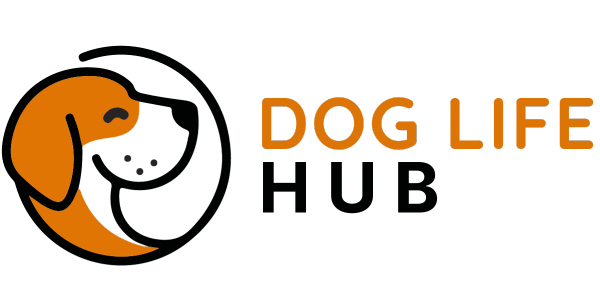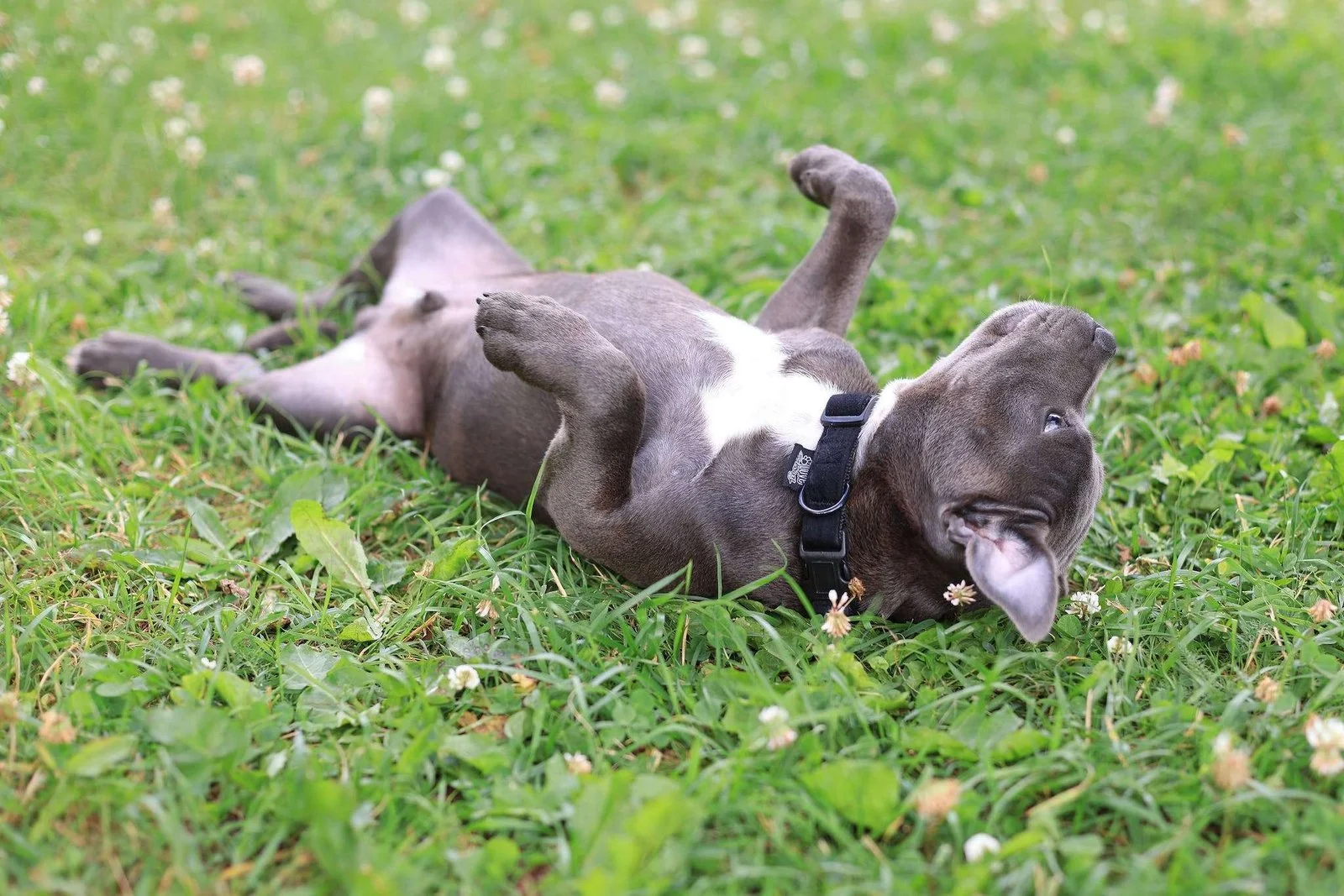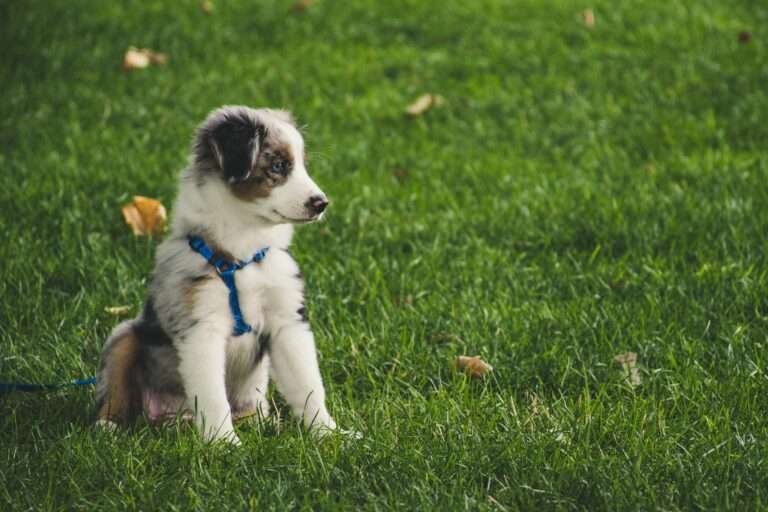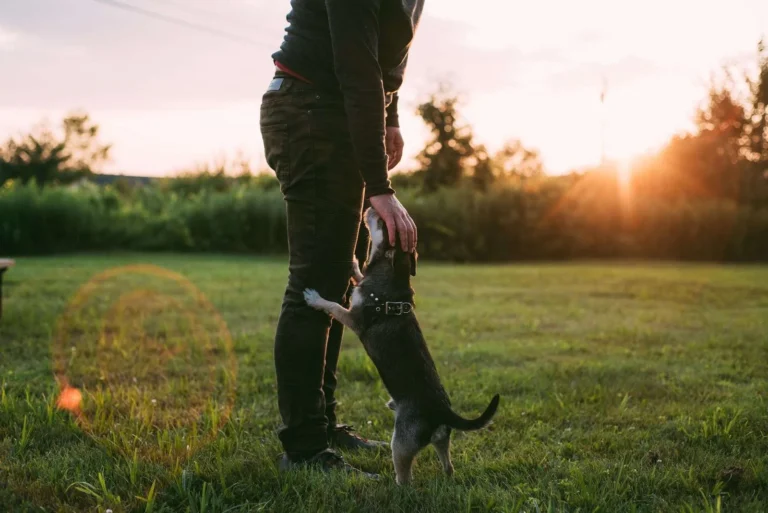How to Teach Your Dog to Roll Over
Teach Your Dog to Roll Over
Title: How to Teach a Dog to Roll Over
I. Introduction
Training dogs extends beyond the basics of ‘sit’ and ‘stay’ commands; it’s a journey that could continue for the rest of your dog’s life! Dogs are eager to learn if the circumstances are right – they love learning and they love pleasing their human.
Once you’ve taught your dog to sit and stay, you can move on to teaching them to roll over. This command not only showcases your dog’s skills but also makes it easier for the vet to examine them.
In this article, we’ll explore the nuances of dog learning and behaviour, prepare you for the training session, and guide you through the step-by-step process of teaching your dog to roll over.
From understanding your dog’s cues to troubleshooting common challenges, this guide aims to equip you with the knowledge and skills to teach your dog the roll over command.
Understanding Canine Learning and Behaviour
Dogs, renowned for their ability to learn and adapt, thrive on positive reinforcement. This method, which involves rewarding desirable actions, forms the cornerstone of effective canine training. Repetition and reward-based techniques help dogs associate specific behaviours with positive outcomes, making learning a pleasant experience for them.
Canine body language is pivotal in understanding their response to training. Subtle cues such as tail wagging, ear positioning, and body posture provide insight into their comfort and receptiveness to learning. These signals are crucial for gauging when to push forward with training or when to take a break.
Timing and consistency are the pillars of teaching new tricks. A dog’s short-term memory is fleeting, so immediate rewards for desired actions cement their learning. Similarly, consistent training sessions help in reinforcing behaviours, making them second nature to the dog. This consistency also extends to verbal commands and hand signals, ensuring the dog doesn’t receive mixed messages during their learning process.
By understanding how dogs learn and interpreting their body language, owners can create a conducive and effective training environment. The key lies in patience, keen observation, and a consistent approach, setting the stage for a rewarding training journey.
Preparing for the Training Session
Before embarking on the ‘roll over’ training journey, setting the right environment and mood is crucial. Choose a space that is comfortable and free of distractions, where your dog can focus solely on you. An area with a soft surface, like grass or a carpeted room, is ideal to ensure your dog’s comfort while rolling over. Who would want to perform tricks on a cold, hard floor?
Selecting the right rewards is vital. While treats are a popular choice, not all dogs are food-motivated. Some may prefer a favourite toy or praise. Whatever excites your dog the most, use that as a reward. If your dog is food motivated, keep the treats small and tasty and within his or her daily food intake allowance.
Ensuring your dog is in the right mood for learning is just as important as the training environment. Look for signs of readiness, such as alertness and a relaxed demeanour. If your dog appears disinterested or stressed, it may be best to postpone the session. Remember, a happy dog is a receptive learner.
It’s also essential to schedule training sessions when your dog has energy but isn’t overly excited. Post-meal times or after a little exercise can be ideal, as your dog might be more focused and less prone to distractions.
In summary, a comfortable environment, appropriate rewards, and a receptive mood are key factors in setting up a successful training session. With these elements in place, you’re well-prepared to begin teaching your dog to roll over.
Basic Commands as a Foundation
Mastering basic commands is an essential foundation for teaching your dog more complex tricks like ‘roll over’. These fundamental commands, including ‘sit’, ‘stay’, and ‘down’, are building blocks that establish a communication line between you and your dog, fostering mutual understanding and respect.
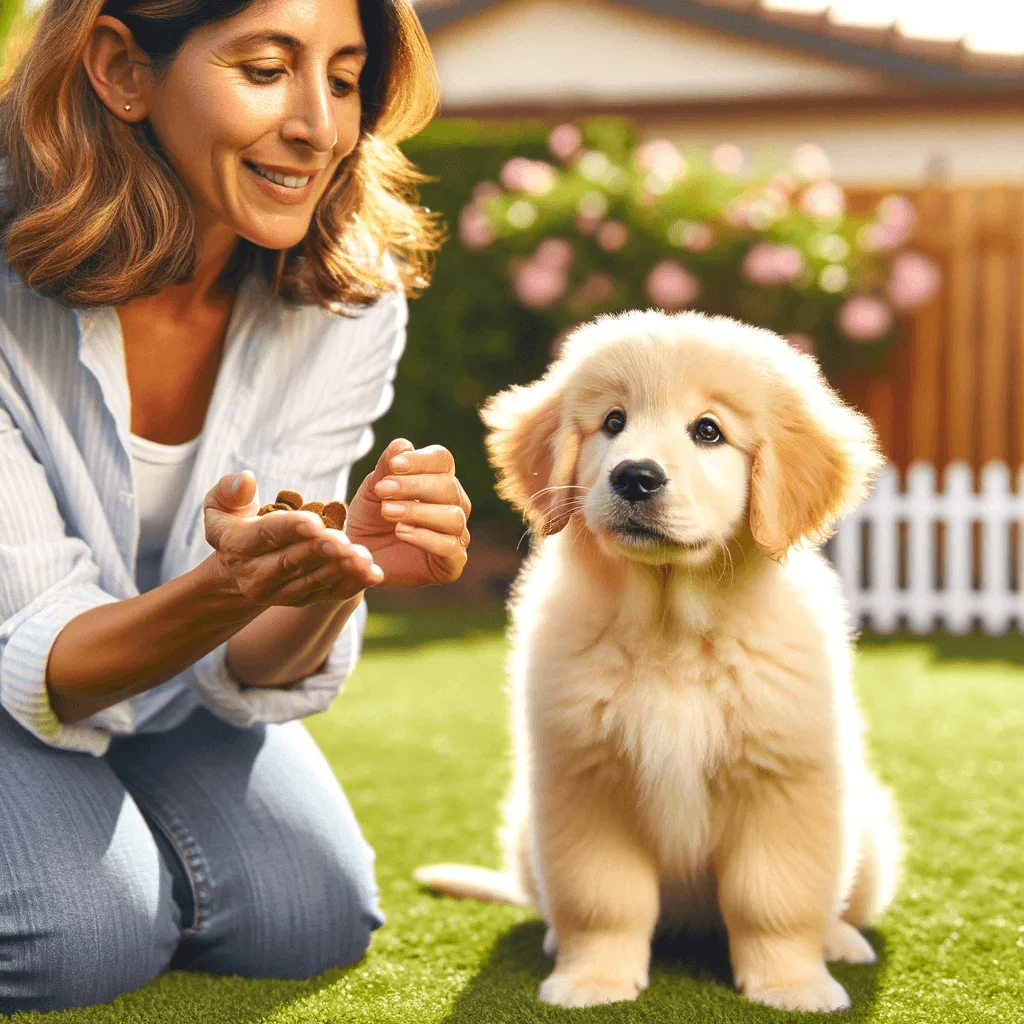
Step-by-Step Guide to Reinforcing Basic Commands:
- Sit: Begin with the simplest command. Hold a treat close to your dog’s nose and slowly move your hand up. As your dog’s head goes up, their bottom will naturally go down. Once they’re sitting, say “sit,” give them the treat, and show affection.
- Stay: Once your dog has mastered ‘sit’, move on to ‘stay’. Ask your dog to ‘sit’, then open your palm in front of you, and say “stay”. Take a few steps back. If they stay put, reward them. Gradually increase the distance and duration.
- Down: From the ‘sit’ position, hold a treat in front of their nose and slowly bring it down to the floor. Their body should follow. Once fully down, say “down,” give the treat and praise.
Transitioning to ‘Roll Over’:
Once your dog consistently responds to these commands, they’re ready to learn ‘roll over’. These basic commands help your dog understand that following cues leads to positive outcomes, making them more likely to succeed with ‘roll over’. Each command teaches patience, attention, and submission, which are essential for smoothly transitioning to more complex tricks.
The Step-by-Step Training Process for ‘Roll Over’
A. Getting Your Dog into a ‘Down’ Position
Start with your dog in a ‘down’ position. This familiar position ensures they are already halfway through the roll over movement. Use the ‘down’ command, guiding them gently if needed. Once they are comfortably lying down, you’re ready to move to the next step.
B. Using a Treat to Guide the Dog into Rolling Over
Hold a treat near your dog’s nose to get their attention. Slowly move the treat from their nose towards their shoulder, encouraging them to turn their head and follow the treat. As they follow the treat with their nose, they should naturally roll to one side to get it. This movement is the essence of the ‘roll over’ trick.
C. Adding the Verbal Cue ‘Roll Over’
As your dog begins to roll, introduce the verbal cue “roll over”. Say it clearly and enthusiastically as they perform the action. Timing is crucial – the command should be associated with the action. Once they complete the roll, reward them immediately with the treat and praise.
D. Practice and Repetition for Mastery
Repetition is key in dog training. Continue practicing the ‘roll over’ trick in short, frequent sessions. Gradually reduce the reliance on treats, replacing them with verbal praise and affection. Remember, patience is essential, as some dogs may take longer to master this trick than others.
Common Mistakes and How to Avoid Them
- Rushing the process: Don’t expect your dog to learn ‘roll over’ in one session. Break it down into smaller, manageable steps.
- Inconsistent commands: Always use the same verbal cue and hand signal for ‘roll over’.
- Frustration: Stay calm and positive. If you or your dog becomes frustrated, take a break and try again later.
Tips for Ensuring Success at Each Stage
- Keep training sessions short and fun. If your dog enjoys the process, they’re more likely to learn quickly.
- Use high-value treats initially, then gradually switch to praise as the main reward.
- Celebrate small victories. Even a partial roll is progress and should be rewarded.
By following these steps, you can effectively teach your dog the ‘roll over’ trick.
Troubleshooting Common Challenges
Training a dog to roll over can come with its unique set of challenges. Here’s how to address some common issues:
- Hesitation or Partial Rolls: If your dog only completes part of the roll, they may not understand the full command or might be uncomfortable with the action. Go back a step, using the treat to guide them through the full motion more slowly. Ensure the surface is comfortable for rolling.
- Distraction: Training requires focus, which can be hard in a distracting environment. If your dog is easily distracted, try training in a quieter, more familiar place. Keep sessions short to maintain their attention.
- Breed and Temperament Variations: Not all breeds or individual dogs will find rolling over easy or comfortable. For example, large or long-bodied dogs might find the trick physically challenging. Adapt the training to suit your dog’s physical capabilities and temperament. If it’s not working, consider alternative tricks that are more comfortable for them.
- Older Dogs or Dogs with Physical Limitations: Be mindful of any physical constraints. For older dogs or those with joint issues, consult your vet before attempting this trick. Always prioritize your dog’s health and comfort.
Patience and understanding are key when training. Every dog is unique, so what works for one might not work for another. Tailoring your approach to your dog’s individual needs and limitations will make the training process more enjoyable and effective for both of you.
Advancing and Diversifying Dog Training
Once your dog has mastered ‘roll over’, you can start to introduce variations and combine it with other tricks. This not only keeps training sessions interesting but also enhances your dog’s cognitive and physical abilities.
- Introducing Variations: Once your dog is comfortable with rolling over, you can add variations. For instance, ask them to ‘roll over’ multiple times in a row or combine ‘roll over’ with ‘play dead’ for an fun sequence.
- Combining with Other Tricks: Link ‘roll over’ with other commands like ‘sit’, ‘stay’, or ‘shake hands’. This creates a routine of tricks that can be both mentally stimulating and entertaining.
- Incorporating into Playtime: Blend ‘roll over’ into your regular playtime. For example, during fetch, ask your dog to ‘roll over’ before throwing the ball. It turns a simple game into a fun training opportunity.
- Challenges for Agility and Responsiveness: Create obstacle courses that include a ‘roll over’ station. This not only improves their agility but also reinforces their responsiveness to your commands.
Advanced training sessions like these not only solidify your dog’s understanding of the trick but also strengthen your bond through shared activities. They keep your dog’s mind sharp and body active, contributing to their overall well-being.
Maintaining and Building on Training Progress
Maintaining and enhancing your dog’s training progress requires consistent practice and reinforcement. Regular training sessions help to solidify the skills they’ve learned and prevent them from becoming rusty. It’s important to integrate tricks like ‘roll over’ into your daily interactions with your dog, making them part of your routine rather than occasional activities.
- Consistent Practice: Incorporate short training sessions into your daily schedule. This regularity helps your dog remember and refine their skills.
- Reinforcement: Continue to use positive reinforcement, like treats and praise, to encourage your dog. Even as they master the trick, acknowledging their efforts maintains their motivation.
- Ongoing Learning: Dogs are capable of lifelong learning. Keep challenging them with new tricks or variations of existing ones to keep their minds active and engaged.
By fostering a continuous learning environment, you not only maintain your dog’s skills but also contribute to their overall happiness and well-being.

Using Clicker Training To Teach Your Dog to Roll Over
How Clicker Training Works:
- Introducing the Clicker: Initially, you need to create an association between the click sound and something positive, usually a treat. Every time you click, immediately give your dog a treat. This step is known as ‘charging’ or ‘tuning in’ the clicker.
- Timing is Key: The clicker is most effective when used to mark the precise moment your dog performs the correct action. For example, as soon as your dog starts the roll over movement, click and then reward.
- Combining Verbal Commands and Clicker: Once your dog associates the click with a positive reward, start using it alongside verbal commands. Say “roll over”, guide your dog through the motion, click the moment they perform the action, and then reward.
- Phasing Out the Clicker: As your dog masters the trick, start to delay the click and treat, gradually replacing them with verbal praise or other forms of reinforcement.
Benefits of Clicker Training in ‘Roll Over’:
- Clear Communication: The clicker sound is distinct and consistent, making it easier for dogs to understand what behaviour is being rewarded.
- Speeds Up Learning: Clicker training can speed up the learning process by clearly marking the desired behaviour.
- Builds Confidence: Dogs learn to associate the click with success, which can boost their confidence and enthusiasm for training.
Tips for Successful Clicker Training:
- Keep the clicker with you during training sessions.
- Be consistent with your clicks and rewards.
- Gradually replace the clicker and treats with verbal praise and affection as your dog learns.
Incorporating clicker training into teaching your dog to ‘roll over’ can enhance the training experience, making it more efficient and enjoyable for both you and your dog.
Thanks for reading! If you have any suggestions, comments or questions, please leave them below – we’d love to hear from you!
